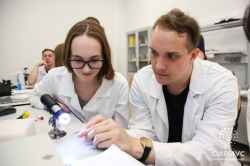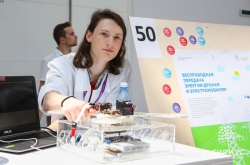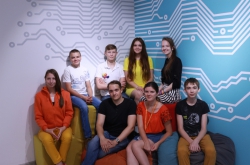Why is the project-based learning method so effective?
Mikhail Mukhin: What does the standard learning method involve? A student attends lectures, participates in seminars, turns in their lab works, but is often at loss on how to apply their knowledge to real-world tasks. In the project-based model of learning, as suggested by its name, projects take the center-stage. Their focus, be it engineering, science, or something else, is not of great importance; what matters is to have an open-answer, unsolved task. We group three to five people around a task, set an objective, and let them do their thing.
Iana Muzychenko: It’s important to note that these are not like lab work that commands students to ‘look at the display of the device, push this button and write down the result’.
Mikhail Mukhin: Yes, what makes project-based learning different is that students have a creative carte blanche. We say to them: it’s you who decide how to approach this project; which solution to pick, equipment to use, and academic literature to draw from, it all depends on you. School and university students feel like they’re in charge of the projects, so the oft-experienced lack of motivation is no longer a problem. Building on our practical knowledge and understanding, we decided to create a learning methodology that revolves around project activities for our scientific field of nanomaterials.

Tell us how you tested the methodology at ITMO University.
Mikhail Mukhin: We introduced project activity as a specific subject for first-year students at the Faculty of Physics and Engineering this spring. There is a global problem in the marine industry: the need for a multicolor coating for ships that would prevent biofouling during long stays in ports. Because of the growing bacteria and algae, ships have difficulties with moving in open waters, and there’s no solution to this problem as of yet. We offered students to create the coating with the help of nanomaterials.
When they heard the task, their first instinct was to search the Net for academic literature on paint modification and prevention of biofouling. We encouraged them to move away from classical textbooks and read the latest research papers in scientific journals and other reliable and topical sources.
It was important for us to ensure an in-depth immersion to the problem the students were working with, so we organized two introductory lectures as well as workshops for practicing with lab equipment. It was up to them to choose the devices to use in their work, though. One team needed a scanning probe microscope, another a scanning electron microscope, the third a chemical cabinet. The students were given a tutorial on all the equipment and help in using it on their own. They also created special devices they needed by themselves. One team even built an aquarium for their experiments.

Iana Muzychenko: Each team was assigned two mentors tasked with consulting them in their work. Emphasis on consulting: they weren’t meant to offer solutions, just listen to the teams’ ideas and help them decide whether these were feasible or not. Project consultants also shared their experience on organizing the working process: how to allocate tasks and manage to do them before the 15-week deadline. This role was taken on by our faculty’s experts.
At the end of the course, the students presented and defended their projects. Though there was one winner, all participants gained new knowledge and experience they wouldn’t have gotten from other courses: how to use specialized laboratory equipment, build a solid theoretical background, work in teams and allocate tasks. What also makes project work so great is that it also develops soft skills which are paramount for a successful career.
Mikhail Mukhin: Project activities have two main goals. The first is educational. During their work on a project, participants learn to source the right theoretical references and literature. The second is getting a tangible result: a prototype, description of a technology, or even completed object which you can hold in your hands. Different project tasks can come with slight variations of these goals, however. Some tasks are solely educational, with the result being not so important. Others have an obvious solution, and what matters here is their engineering execution. But what the Faculty of Physics and Engineering students we worked with got in the end was both education and a finished product.

Where did you start with developing this methodology?
Mikhail Mukhin: The project-based education trend in Russia has started at the school level. How did we use to identify talented school students? Through subject-specific academic competitions in chemistry, physics, computer science. So students were taught how to solve complex and, in most cases, very specific competition tasks. That was before a team of specialists looked into the question of whether competition winners were successful in the real-world scientific activities. It transpired that having an in-depth knowledge in a particular subject isn’t enough to succeed, you also need to be able to work in a team, and also to factor in resources and deadlines. It became clear that we had to change this approach by shifting the focus to project-based learning. That’s why about three-four years ago the Agency for Strategic Initiatives set an objective of training 50,000 engineers able to perform project-based tasks by 2035.
We thought that we could use the project-based approach to teaching students nanotechnologies. There’s no need in going into the depths of quantum physics and getting a Master’s and PhD degrees for an introductory dive into a scientific field: you just need to get a clearly defined task and familiarize yourself with the entry-level theory.
Where did you test your methodology?
Mikhail Mukhin: The first onsite application was in Sirius educational center in Sochi: this summer, ITMO University, together with the Fund for Infrastructure and Educational Programs RUSNANO, coordinated a project summer school in nanotechnologies there. Secondly, we cooperate with Quantorium, a federal network of technoparks for kids. These are extremely important projects which are also very interesting for us to participate in (more on this cooperation here).

Next week, our university will welcome our pupils from Sirius. They decided to complete the projects they started in Sochi during their summer holidays. We supported this decision and will help them with their next prototype iteration and co-write a patent application with a research paper.
At whom the methodology is mostly aimed at, school students or university students?
Mikhail Mukhin: We work with both, the main reason being that we’re really excited about teaching nanotechnologies. The additional perk of working with school students is that we can introduce them to the Faculty of Physics and Engineering and ITMO in general, and invite the most talented high schoolers to study at our university. And when working with university students, we try to contribute to their professional development and hope that they’ll grow into high-quality PhD researchers and future associates of the Research Center of Nanophotonics and Metamaterials.
Iana Muzychenko: There is a demand from students. I teach physics workshops with lab equipment and often hear students from other faculties complain about the lack of motivation. You lay out a device, measure, press buttons, write down results, and for what? Then you calculate stuff. What difference does it make? So they say, ‘If ever we had a real task, we’d understand why we do all of this and start to really think what to do and what to get as a result.’

What’s next for your methodology?
Iana Muzychenko: We’ve already introduced it to the first-year curriculum of the Faculty of Physics and Engineering, and what we would like to do next is to add project activity to every semester’s study program as part of some classic discipline, for example, optical physics. We’d offer our students a couple of independent project topics, maybe without a universal, breakthrough final result, but still unsolved and promising.
Mikhail Mukhin: We’d be very glad if our experience inspired other faculties, laboratories and education program managers to introduce the project-based methodology to their activities. We’re willing to help them with that. Any activity can be represented as a project, if there is a task, a deadline, resources, people, information, and you are result-oriented.





